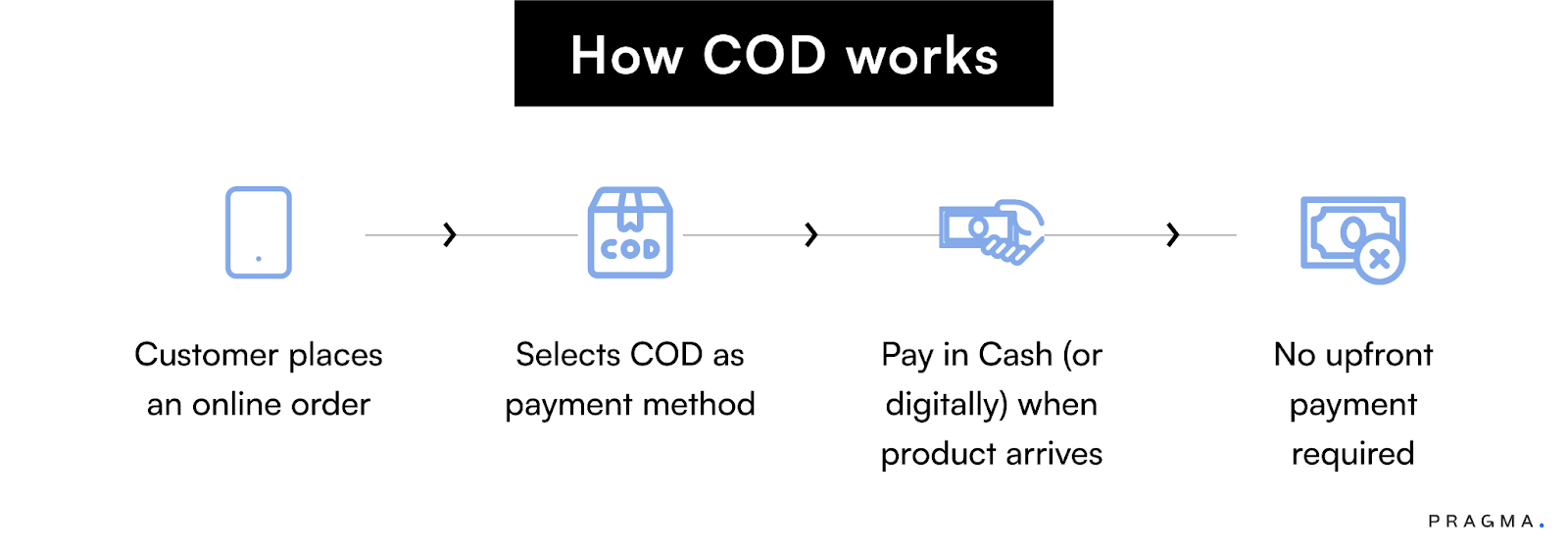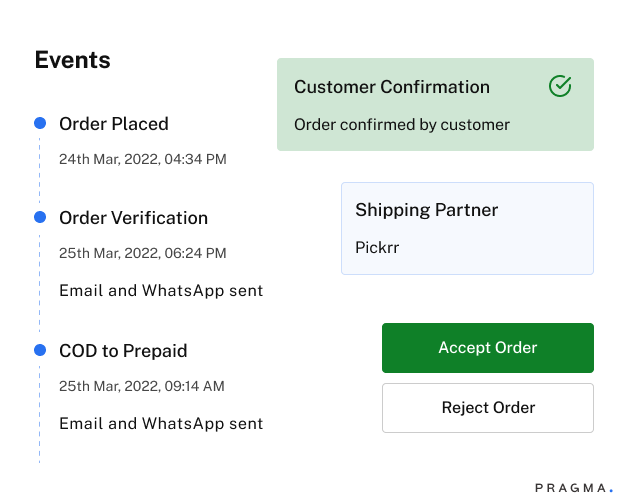In India, the e-commerce brands face a difficult challenge related to payment methods. Most of the businesses always get into a dilemma: should they offer Cash on Delivery (COD), online payments, or both?
This is one of the crucial decisions that e-commerce brands have to make wisely. As a significant proportion of Indian people are of great sentiments, they easily do not trust online payments, but there is a segment that feels comfortable with online payments.
Thus, to solve this confusion, we will delve into "COD Payment vs Online Payment: Best Option for E-commerce Brands". And will help you let you know which payment option works best for your e-commerce brand in 2025-2026.
Understanding COD and Online Payments
Before we dive into the details, let us know the basics about the two payment options.
What is Cash on Delivery (COD)?
As the name implies, Cash on Delivery (COD) is a method where the customer pays for their purchases only when the product is delivered to their doorstep.
According to industry data, COD accounts for approximately 60-65% of total e-commerce orders in India as of 2024. Despite Digital India, the COD accounts for a larger proportion still in today's market.
How does COD work?

- The customer places an order online.
- Selects COD as the payment method
- Pays in cash (or digitally) only when the product arrives
- No upfront payment required
What is Online Payment?
As the name implies, online payments are a form of prepaid payment. It requires customers to pay before the product is shipped.
The payments can be made from the following methods:
- Credit/Debit cards
- UPI (Unified Payments Interface)
- Digital wallets
- Net banking
- Buy Now Pay Later (BNPL) options
Payment Trends in Indian E-commerce
The Indian payment landscape is evolving rapidly:
- UPI transactions grew by approximately 60% in volume in 2023, reaching ₹9.79 trillion transactions.
- Over 40% of consumers in Tier 3-6 cities now use digital payments daily.
- 70% of UPI users now hail from non-Tier 1 cities.
- Digital payment infrastructure has expanded with 4.77 crore digital payment touchpoints deployed in Tier 3-6 cities.
Cash on Delivery (COD): Advantages and Challenges for E-commerce Brands
If you want to decide between COD Payment and Online Payment, you must know the benefits and limitations of both payment methods. Let us start with the COD methods.
What Are The Advantages Of Providing The Cash On Delivery Payment Method To E-Commerce Brands?
1. Builds Trust with New Customers
When a customer reaches a new brand, likes something, and wants to purchase, they definitely look for the COD option because new customers hesitate to trust the brand, and they just want to be in a safer place, in case any discrepancies occur.
So, the cash on delivery option at that time helped e-commerce brands attract new customers and get attached to them. COD helps overcome that hesitation by letting them pay only after receiving the product.
2. Expands Customer Base
COD payments also help brands to add customers who do not use digital payment methods. There are many older people who do not use mobiles to make payments. Such a segment of people can become customers only if D2C brands offer the COD payment method.
3. Increases Order Volume
When a customer feels safer to pay, they are more likely to place orders. And this helps brands to increase their sales.
4. Reduces Cart Abandonment
Some customers abandon carts due to payment gateway issues or a lack of trust. But when they get COD as a payment option, they place the order without leaving the cart. Thus, COD also helps in reducing cart abandonment.
5. Improves Brand Credibility
When any D2C brand offers COD, it signals that your brand is confident in its product and delivery process, enhancing customer confidence and brand image.
6. Expand Market Reach
In India, there are still some regions that are less educated and do not make use of online payment methods. If a brand wants to increase its market in such areas, COD orders help them to get sales from such regions.
What Are The Disadvantages Of Providing The Cash On Delivery Payment Method To E-Commerce Brands?
1. High Returns and RTO Losses
One of the disadvantages that cash-on-delivery orders come with is the occurrence of higher returns. When a customer does not pay, they are more likely to cancel the order or refuse delivery. This leads to RTO- Return-to-Origin. Here are some statistics connected with RTOs:
- 25-30% of COD orders result in RTO, compared to less than 2% for prepaid orders
- COD (Cash on Delivery) RTO rates range from 18% in low-RTO cities up to 35% in high-RTO regions
With such high numbers of RTOs, brands find it difficult to handle everything. To solve this alarming situation, Pragma comes with the RTO Suite, which helps D2C brands to reduce their RTO losses by 60%.
What do we offer?
- Behavioural Analysis
- Helps flag impulse buyers
- Screening of Customer Info
- Check the users for past RTO history
- C2P (COD to Prepaid) Conversion
- Automated NDR Management
- Automated Order Verification
2. Delayed Cash Flow
Since payment happens after delivery, brands get their money much later compared to prepaid orders. This affects working capital and cash management.
3. Leads to More Operational Costs
As COD orders come with the risk of returns. It leads to various costs:
- Double logistics costs for returned orders
- Additional cash handling fees from courier partners
To avoid such high costs, Pragma helps brands convert the COD orders to be prepared through the Pragma C2P Conversion.
We have helped various brands achieve a 25 to 35% increase in paid orders through our C2P strategy. How do we do this?

With the help of WhatsApp, SMS, or emails, we send customers the offers regularly that the sellers approve.
4. Higher Risk of Order Cancellations or Fraud
Because customers don't pay in advance, they may cancel impulsively or refuse delivery. This causes losses and inventory issues.
To solve this issue, Pragma comes with its COD Verify. Pragma's automated COD Verify confirms the orders through messages once they are placed and also again after a specific period of time.

It makes use of WhatsApp, SMS, or emails for a mode of communication, where 72% prefer WhatsApp for this.
5. High Dependence on Delivery Partners
Brands rely on courier partners to collect and settle payments accurately. This can sometimes lead to delays or accounting errors.
What are the Benefits and Limitations of Online Payments?
Now, let us know about the online payment methods. Have a look at the following:
Benefits of Online Payments
1. Faster Transactions and Better Cash Flow in Business
- Immediate payment made by customers to improve cash flow in the business.
- It helps to lower operational costs because there is no cash handling.
- It reduced dependency on logistics partners for payment collection.
2. Easier Order Processing
Since payment is confirmed upfront, order fulfilment becomes faster and smoother, reducing the chances of fake or cancelled orders.
3. Lower Return to Origin (RTO) Rates
When a customer has already paid through online methods, they are less likely to cancel an order. And this saves brands from the chances of RTOs. At last, they can save a lot through prepaid orders.
4 Increasing Sales Globally
Online payment options allow brands to sell globally and attract international customers easily.
Limitations of Online Payments
1. Payment Failures
One of the most irritating disadvantages of online payments is transaction failures. It can be due to network errors, server downtime, or gateway glitches, which can frustrate customers and reduce conversions.
2. Lack of Trust Building for Customers
Most of the customers hesitate to make a payment online due to high instances of fraud prevailing in India.
3. Risk of Online Fraud or Data Breach
There's always a risk of hacking or any other fraud in case of online payments, which can harm both customers and the brand's reputation.
4. Transaction Brands and Charges
As online payments are made with the help of payment gateways. These gateways charge some fees on each transaction. This can lead to reduced profits for the business.
COD vs Online Payment: Key Differences

India's Shift Toward Digital Payments
UPI & Wallets Changing Checkout Behaviour
Over the past few years, we have seen a shift towards the use of UPIs for digital payments.
The numbers are fascinating:
- The number of UPI transactions had reached 117.6-118 billion or ₹9,760 – ₹9,790 billion in the year 2023.
- Digital payments are projected to grow threefold from ₹159 billion in FY24 to ₹481 billion by FY29.
- We all have seen how contactless payments became preferred during the pandemic.
Government Push for Cashless Transactions
To push the use of digital payment methods, the government has also launched various programs and provided schemes and incentives to grow it faster:
- The Payments Infrastructure Development Fund (PIDF) has enabled the deployment of 4.77 crore digital payment touchpoints.
- GST benefits for digital payment users
- Banking infrastructure improvements in rural areas, initiatives like Pradhan Mantri Jan Dhan Yojana (PMJDY) to open bank accounts for everyone with a zero limit.
- Financial inclusion programs are expanding digital access, like Pradhan Mantri Gramin Digital Saksharta Abhiyan (PMGDISHA).
Data Insights: COD Decline in Tier 1 & Tier 2 Cities
Market data reveals changing preferences:
- Tier 1 cities: Increasing digital payment adoption
- Tier 2 cities: Account for 80% of new UPI registrations
- Tier 3-6 cities: Over 40% of consumers use digital payments daily
Should E-commerce Brands Still Offer COD?

So, the race between COD Payment vs Online Payment is still not over. The answer to this question would be a YES!
Yes, the brands should offer the COD option as a payment method, but that totally depends on specific scenarios.
We will suggest brands to do the following:
When does COD help build Trust for New Users?
Brands should choose COD when:
- They see first-time customers who are testing new brands.
- They see high-value purchases where customers want to inspect products.
- They want to enter the rural market with limited digital infrastructure.
- They see elderly customers who are uncomfortable with online payments.
When to Encourage Online Payments for Conversions?
E-commerce brands should push for prepaid when:
- Repeat customers are purchasing with established trust.
- They are dealing in urban markets, which have high digital adoption and are adequately aware of it.
- There are low-value orders where COD costs are disproportionate.
- There are peak seasons, where customers buy impulsively to reduce operational burden.
Finding the Right Balance: Hybrid Checkout Strategy
The most successful ecommerce brands use a data-driven hybrid approach rather than choosing between COD and online payments.
67% of first-time buyers prefer COD, but returning customers are 3x more likely to use prepaid methods.
Smart brands implement risk-based COD availability, allowing COD for low-risk customers while blocking it for pin codes with RTO rates>40%.
The key is progressive customer migration: they first offer COD to build initial trust, then incentivise digital payments with 5-10% discounts and faster delivery.
Successful brands typically achieve a 60% prepaid, 40% COD mix within 12 months, reducing RTO costs by 25%.
This is how an innovative and successful D2C e-commerce brand builds a balance between COD Payment and Online Payment.
Best Practices for Managing COD and Online Payments Together- How can Brands Maintain a Balance between both?

1. Implement Smart COD Controls
- Set minimum order values for COD (₹500-1000)
- Charge COD convenience fees (₹50-100)
- Use geolocation data to identify high-risk areas
- Implement automated order verification
For this, you can use Pragma RTO Suite, which helps automate order verification and flag risky orders at the time of placing.
2. Provide Incentives to encourage prepaid Payments
To convert more of COD orders to prepaid brands, do the following:
- Offer 5-10% discounts on prepaid orders
- Provide exclusive deals for digital payment users
- Create loyalty programs that reward online payments
Pragma's C2P strategy helps the brand convert about 25 to 35% of COD orders to prepaid ones.
3. Use Technology for Risk Management
Advanced solutions like Pragma RTO Suite can help brands:
- Automatically verify COD orders before dispatch
- Convert COD to prepaid with personalised incentives
- Block high-risk orders based on data analytics
- Process instant refunds for a better customer experience
Pragma helps to automate COD Refunds, through which customers just need to create Cashfree's Cashgram URL and have it sent automatically via WhatsApp. There is no need to add customer details of your bank accounts.
4. Choose according to the Regions
Brands should maintain a balance between COD Payment and Online Payment according to the region they are dealing with. They can adopt the following:
- Push digital payments with incentives in urban areas.
- Should offer payment options, both with slight COD fees in semi-urban areas.
- They should maintain COD, but with verification in rural areas.
- Disable or limit COD availability at high-risk pincodes. With 1Checkout by Pragma, brands can disable the COD option for high-risk orders.
5. Customer Education and Support
Brands should educate customers about online payment security. They should provide multiple payment options at checkout. Also, every D2C brand should offer proper customer support to those who face payment-related issues and must resolve them as soon as possible.
To Wrap It Up
To conclude, here we want to say that the choice between the COD Payment vs Online Payment is not single-handed. E-commerce brands to be successful must find the right balance between both.
While online payments offer better unit economics and operational efficiency, COD remains crucial for market expansion, especially in Tier 2+ cities.
With the right strategy, brands can find the right approach between both. And Pragma is here for all D2C brands to achieve a successful business through automations.

FAQs (Frequently Asked Questions on COD Payment vs Online Payment: Best Option for E-commerce Brands)
1. What is Cash on Delivery (COD) and how does it work?
Cash on Delivery (COD) is a payment method where the customer pays for their online order at the time of delivery, rather than upfront.
For example, in India many online shoppers choose COD as it gives them the option to inspect the product before paying.
2. What is an online payment option?
An online payment is when the customer pays for their order during the checkout process using digital wallet, net-banking, credit/debit card, UPI or prepaid options. This payment is captured before the order ships.
3. Why might a brand choose COD over online payment?
- COD can help reduce purchase hesitation among first-time buyers or in regions with low digital-payment adoption.
- It can expand reach into Tier-2/3 towns where digital payment trust or infrastructure may be lower.
4. What are the key drawbacks of COD?
- Higher risk of order refusal or Return-to-Origin (RTO) because payment is collected at delivery.
- Delay in cash-flow for the brand, as payment may take time to be remitted.
- Additional logistic and handling cost, and increased risk of fraud in some cases.
5. What are the advantages of online payment for brands?
- Payment is received before dispatch, improving cash-flow and lowering risk of non-payment.
- Seamless checkout experience can enhance conversion.
- Better control over fraud, and fewer failed deliveries.
6. Are there any situations where online payment may be less optimal?
Yes. For example:
- In markets or segments where digital-payment usage is low.
- Among customers who prefer to inspect the product before paying.
- Where trust is still forming between brand and customer.
7. How should D2C e-commerce brands decide between COD and online payment?
Brands should consider:
- Customer behaviour and preference in target regions (Tier-2/3 versus metro).
- Cost of handling COD versus benefit of expanded reach.
- Logistics partner reliability and payment-collection efficiency.
- Whether online-payment UX is optimised for mobile and local context.
8. Can a brand offer both COD and online payment?
Yes. Many brands offer both, using intelligent rules:
- Allow COD for new customers in certain regions with verification.
- Encourage or incentivise online/prepaid payments (discounts, faster shipping).
- Limit COD for high-value orders or high-RTO areas.
9. What are some best-practice tips for managing COD and online payment mix?
- If offering COD: set clear eligibility rules (order value cap, region filters), confirm order before dispatch.
- Ensure online payment checkout is smooth: minimal fields, mobile-optimised, visible payment options.
- Track payment mode-wise metrics: RTO rate, conversion rate, payment failure rate.
- Regularly review and adjust the mix based on cost, conversion and customer behaviour.
Talk to our experts for a customised solution that can maximise your sales funnel
Book a demo




.png)